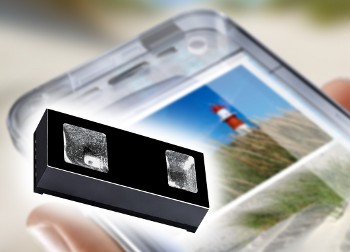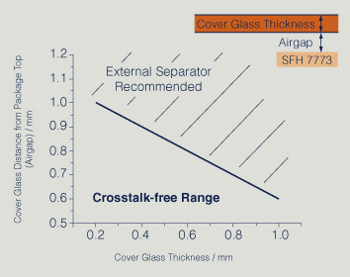 |
| March 20, 2012 | Volume 08 Issue 11 |
Designfax weekly eMagazine
Archives
Partners
Manufacturing Center
Product Spotlight
Modern Applications News
Metalworking Ideas For
Today's Job Shops
Tooling and Production
Strategies for large
metalworking plants
Engineer's Toolbox:
Crosstalk on smartphone? No problem!

SFH 7773 is a combined proximity and ambient light sensor. It accommodates emitter and detector in one package and impresses with its straightforward use and adaptability to versatile applications. [Image: OSRAM]
A new hybrid sensor from OSRAM Opto Semiconductors eases the installation of proximity and ambient light sensor technology in smartphones and similar devices. The sensor combines emitter and detector, and it is designed to eliminate crosstalk in many applications. Suppressing this effect normally requires large efforts. For the first time, designers are also able to adapt the sensitivity of the ambient light sensor to the transparency of various smartphone covers.
The digital sensor SFH 7773 detects objects up to a distance of 15 cm and simultaneously measures the intensity of the ambient light. Its black, 5.3 x 2.5 x 1.2-mm-large package is hardly noticed behind transparent covers of smartphones. Thanks to highly efficient chip technologies, its power consumption is low a maximum of 5 mA flows in stand-by mode, 300 mA in operation and therefore it is ideally suited for portable devices.
Design prevents reflections
Proximity sensors detect objects by receiving the reflection of an emitted light signal. But the cover of a smartphone, for example, also reflects light back to the sensor. This so-called crosstalk usually is intercepted by installing an optical barrier. Alternatively, the emitter is placed at a distance that prevents the cover reflections to reach the detector. However, both alternatives are rather complex. That's one big reason why OSRAM developed the SFH 7773, so that designers do not have to worry about crosstalk anymore: Inside the device, emitter and detector chip are located sufficiently far apart from each other. Additionally, apertures are integrated in the package that prevent crosstalk or significantly reduce it.

For many designs, the combined proximity and ambient light sensor SFH 7773 makes crosstalk suppression redundant. [Source: OSRAM]
User-definable sensitivity
To a large extent, the user is free to select the integration time of the detector and thus the detection range of the proximity sensor via the IēC interface. That way, the ambient light sensor can also be adjusted to the transparency of the smartphone cover. A variety of sensitivity levels is available, ranging from 3 to approximately 65.500 lux and 0.03 to 655 lux.
"This means that, for the first time, customers can optimize the device for their respective application from the operating distance to the sensitivity of the ambient light sensor," says Bianka Schnabel, the sensor's product marketing manager. "Due to this considerably simplified design work and flexibility of use, combined ambient light and proximity functions become more attractive for the middle segment of portable devices."
Want more information? Click below.
OSRAM Opto Semiconductors SFH 7773 sensor specifics/app note .pdf
Source: OSRAM Opto Semiconductors
Published March 2012
Rate this article
View our terms of use and privacy policy
